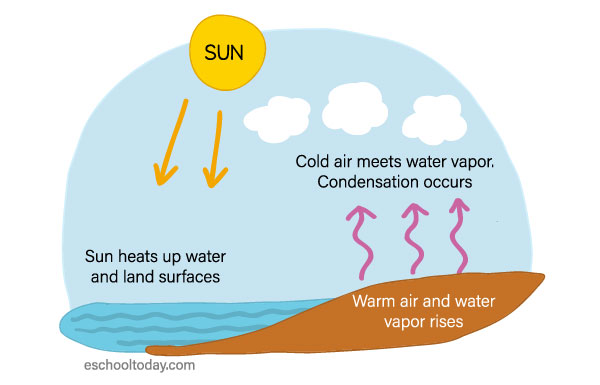- Clouds
How do clouds form in the sky?
Clouds form by a process called condensation. Before we look at the details, here is an activity you can try at home.
Put a pot of water on the stove and bring it to a boil. Take a dry lid and cover it for a minute, and lift the lid. What happens? Water droplets run down the lid and fall back into the pot. That is what happens during condensation.
The atmosphere is made of gases including water vapor. Sometimes more water vapor is added when water on the earth’s surface turns into a gas (evaporates) by the action of the sun’s heat. Plants also produce water vapor from their leaves in a process called transpiration.

Water vapor rises because it is warm air and less dense than cold air. It can also rise if a moving cold front (which is denser) meets a warm front. The cold front can push itself under it and force the warm front to rise. As water vapor rises into the atmosphere they mix up with very tiny particles of dust, soot, and salt, which are particulate matter. These particles are called aerosols. The water particles are held up by strong vertical winds or convectional currents. As they continue to rise, they expand and cool down. The warm air with moisture cools through adiabatic cooling.
As the surrounding temperatures fall, water vapor reaches the dew point, and the water vapor turns into very tiny particles of water and ice crystals. The water particles bump into the aerosols and stick together. As more and more water particles and aerosols stick together, clouds are formed. This process is known as coalescence. Cloud droplets can range from sizes between 10 microns to about 1 millimeter.
Soon, there is so much moisture in the atmosphere in the form of water-bearing clouds, far more than the air in that region can take. Here, we say there is saturation, and the water/ice crystals are ready to come down in the form of precipitation.
